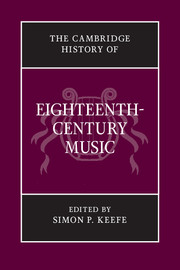Book contents
- Frontmatter
- PRELUDE
- PART I MUSIC FOR THE CHURCH
- INTERLUDE
- PART II MUSIC FOR THE THEATRE
- INTERLUDE
- PART III MUSIC FOR THE SALON AND CONCERT ROOM
- POSTLUDE
- 24 Across the divide: currents of musical thought in Europe, c. 1790–1810
- Appendix I Chronology
- Appendix II Institutions in major European cities
- Appendix III Personalia
- Index
- References
24 - Across the divide: currents of musical thought in Europe, c. 1790–1810
from POSTLUDE
Published online by Cambridge University Press: 28 March 2011
- Frontmatter
- PRELUDE
- PART I MUSIC FOR THE CHURCH
- INTERLUDE
- PART II MUSIC FOR THE THEATRE
- INTERLUDE
- PART III MUSIC FOR THE SALON AND CONCERT ROOM
- POSTLUDE
- 24 Across the divide: currents of musical thought in Europe, c. 1790–1810
- Appendix I Chronology
- Appendix II Institutions in major European cities
- Appendix III Personalia
- Index
- References
Summary
Early in 1801, Johann Karl Friedrich Triest (1764–1810) surveyed the German musical scene of the previous century in a series of articles in the Leipzig-based Allgemeine musikalische Zeitung, entitled ‘Bemerkung über die Ausbildung der Tonkunst in Deutschland im achtzehnten Jahrhundert’. Though not without its quirks – including a quaintly nationalistic claim for ‘works that only German toil and diligence can produce’ – it is an important document, poised perfectly at the century divide. Many of Triest’s historical perspectives resonate (to a lesser or greater extent) with common twentieth- and twenty-first-century perspectives on eighteenth-century music, including his sub-division into three periods that comprise ‘the beginning. . . to the death of Joh. Seb. Bach’, ‘Graun, Hasse, C. P. E. Bach et al. to Jo. Haydn and Mozart’ and ‘Mozart to the end of the century’, his appreciation of Bach, Haydn and Mozart’s pre-eminence and his identification of the third quarter of the century as an ‘interim period’. Triest is also refreshingly self-aware as a historian, recognizing the ‘chameleon shapes’ of musical development in the late eighteenth century as ‘ever more difficult to follow’ and the ‘present ferment of the practical art of music’ as an impediment to determining future directions of travel.
- Type
- Chapter
- Information
- The Cambridge History of Eighteenth-Century Music , pp. 661 - 688Publisher: Cambridge University PressPrint publication year: 2009



